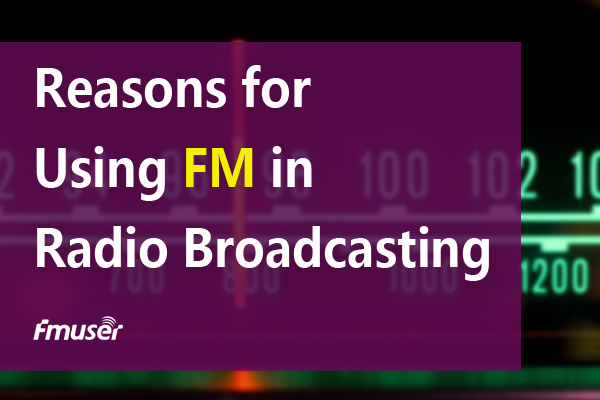
Hot tag
Popular search
Contents
- Amplitude Modulation
- Frequency Modulation
- Anti-interference Ability
- Transmission Quality
- Transmission Distance
- Construction Cost
- 1. Q: Is Running a Low-power FM Station Legal?
- 2. Q: What Equipment is Needed to Launch a Low-power FM Radio Station?
- 3. Q: What are the Advantages of the Low-power FM Transmitters?
- 4. Q: What Other Applications Can a Low-power FM Transmitter be Used in?
Why Do We Need FM in Radio Broadcasting?

Nowadays, the most widely used modulation methods in radio broadcasting are AM and FM. In history, AM broadcasting appeared decades earlier than FM broadcasting, but finally, people adopt FM broadcasting antenna in radio broadcasting more. Although AM is still very important, it has been less used. Why do we need FM in radio broadcasting? This article will answer this question by comparing the differences between AM and FM. Let's start!
Sharing is Caring!
Content
Types of Radio Broadcasting
Let's first learn about AM and FM. In radio broadcasting, there are three main modulation methods: amplitude modulation, frequency modulation, and phase modulation. Phase modulation is not widely used yet. And today we focus on discussing amplitude modulation and frequency modulation.
Amplitude Modulation
AM means amplitude modulation. As the name suggests, it represents the information of audio signals through the amplitude of radio waves. In amplitude modulation, the amplitude of the carrier, that is, the signal strength changes in proportion to the amplitude of the audio signal. In radio broadcasting, AM mainly broadcasts with the long wave and the medium wave, and the corresponding frequency bands are mainly low frequency and intermediate frequency bands (the specific frequency range varies slightly according to the regulations of various countries). Am is often used in short-wave radio stations, amateur radio stations, two-way radio stations, civil band radio stations, and so on.
Frequency Modulation
FM means frequency modulation. Unlike AM, it represents the information of audio signals through the frequency of radio waves. In frequency modulation, the frequency of the carrier signal (the number of times the current changes direction per second) changes according to the change of the audio signal. In radio broadcasting, it is mainly broadcast in VHF frequency bands, and the specific frequency range is 88 - 108MHz (similarly, the regulations of some countries or regions are different).
Although AM and FM play the same role in radio broadcasting, their characteristics in broadcasting are also different due to different modulation methods, and we will describe it in detail in the next part.
What Are The Differences Between AM And FM?
The differences between AM and FM are mainly reflected in these points:
Anti-interference Ability
The original intention of the invention of FM technology is to overcome the problem that the AM signal is easy to be disturbed. But FM uses the change of frequency to represent audio information, so it will not be affected by the amplitude change of the audio signal. In general, FM signals are less susceptible to interference.
Transmission Quality
Each channel of AM occupies the bandwidth of 10KHz, while each channel of FM occupies the bandwidth of 200kHz. This means that FM signals can carry more audio information and transmit the audio signal without distortion. Therefore, FM signals are often used to broadcast music programs, while FM signals are often used to broadcast talking programs.
Transmission Distance
Am signals broadcast radio waves with lower frequencies or longer wavelengths, which means that they can travel farther and penetrate more objects, such as mountains. However, the FM signal is easily blocked by obstacles. Therefore, some important information, such as weather forecasts, traffic information, etc., are transmitted through AM signals. At the same time, in some remote suburbs or mountainous areas, they need AM for radio broadcasting.
Construction Cost
Because FM broadcasting is more complex than AM broadcasting, broadcasting companies need to replace those FM radio transmitters with more complex internal structures and higher costs. At the same time, in order to cover the whole city as possible, they also need to buy multiple transmitters or other broadcasting systems used to extend the broadcasting distance (such as Studio Transmitter Link), which undoubtedly greatly increases the equipment construction cost of broadcasting companies.
Thanks to the excellent broadcast transmission quality of FM, it has been used in the field of radio broadcasting more and more since its emergence in 1933. You can find many related products, FM broadcasting transmitters, FM radios, FM antennas, etc, which are widely used in private and public services such as the car radio, drive-in services, Christmas party, community radio stations, city radio stations, etc. Here's the best selling FM radio broadcast transmitter for low-power fm stations:
Best 50W FM Radio Broadcast Transmitter FMT5.0-50H - Learn More
Frequently Asked Questions
1. Q: Is Running a Low-power FM Station Legal?
A: It depends on your local regulations on Radio Broadcasting.
In most countries worldwide, running a low-power FM station is required to apply for licenses from the local FM & TV broadcasting administration, or you'll be fined. Therefore, please consult the local regulations on community radio in detail before starting up a low-power FM station.
2. Q: What Equipment is Needed to Launch a Low-power FM Radio Station?
A: If you want to start a low power FM radio station, you'll need a series of radio broadcasting equipment, including FM station equipment and studio station equipment.
Here's the list of the basic equipment you need:
- An FM broadcast transmitter;
- FM antennas packages;
- RF cables;
- Necessary accessories.
If you want to add more equipment to the FM radio station, here's the list for you:
- Audio mixer;
- Audio processor;
- Microphone;
- Microphone stand;
- BOP cover;
- High-quality monitor speaker;
- Headphones;
- Headphones distributor;
- etc.
3. Q: What are the Advantages of the Low-power FM Transmitters?
A: Compared with high power FM transmitters, low-power FM transmitters are lighter, easier for transportation, and more friendly to the novices.
Due to its lighter weight and smaller volume, it is much easier for people to remove it. In addition, the easy operation makes people know how to use it in a short time. It reduces labour costs in all aspects.
4. Q: What Other Applications Can a Low-power FM Transmitter be Used in?
A: It can be used in a series of public broadcasting services and meet private broadcasting needs.
Low-power FM transmitters can be used in a wide variety of applications in addition to car radio, drive-in services, Christmas party, community radio stations, city radio stations, including school broadcasting, supermarket broadcasting, farm broadcasting, factory notice, enterprise conference broadcasting, scenic spot broadcasting, advertising, music programs, News programs, outdoor live broadcast, live drama production, correctional facilities, real estate broadcasting, dealer broadcasting, etc.
Start Up An FM Radio Station Now
Even for beginners, it is not difficult to start up their own radio station. Just like others, they need some high-quality and affordable radio station equipment and a reliable supplier. And that's why they choose FMUSER. In FMUSER, you can buy FM radio stations packages at a budget price, including FM radio equipment for sale, FM antennas for sale, and other necessary accessories. If you want to build your own radio station, please feel free to contact us right now!
Also Read
- What FM Broadcasting Equipment Do You Need in Community Radio?
- 5 Things to Consider before Buying an FM Broadcast Transmitter
- What FM Broadcasting Equipment Do You Need in Drive-in Church?
Tags
Related Articles
CONTACT US


FMUSER INTERNATIONAL GROUP LIMITED.
We are always providing our customers with reliable products and considerate services.
If you would like to keep touch with us directly, please go to contact us






